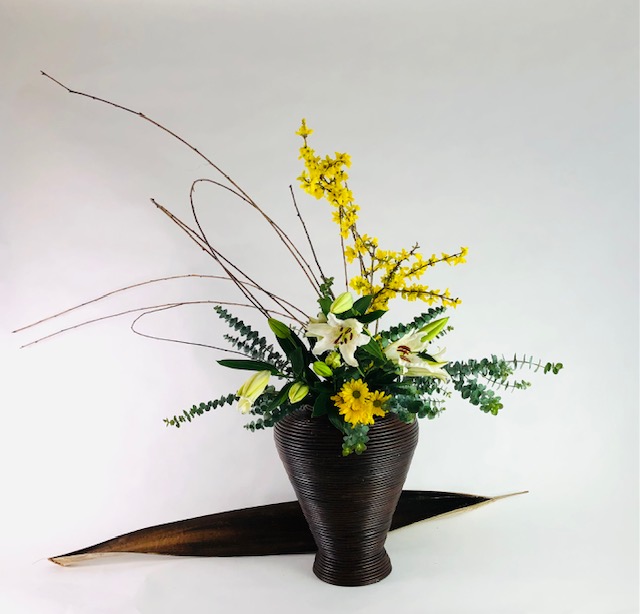The Ohara School was founded in the middle years of the Mieji Period (1868 – 1911) by Unshin Ohara. Until that time, almost all works of ikebana done in bowls or vases were arranged vertically in a “standing” form. This ancient vertical style was characterized by numerous limitations and so many strict, detailed rules that it was impossible to enjoy arranging flowers freely. However, by the time of the Mieji Period, large quantities of Western flowers had begun to be imported and cultivated in Japan. Lifestyles had also begun to change, so the ikebana that had developed from the past no longer suited the actual circumstances of everyday life.
At that time, Unshin Ohara originated a style of ikebana which incorporated the new Western flowers. His arrangements were suitable not only for the tokonoma alcove of traditional Japanese architecture, but for the new Western-style rooms of the period, such as the drawing rooms and entrance halls. Furthermore, he originated a new style of ikebana that gave full play to the creativity of the arranger. The new style was called Moribana. Moribana was subsequently adopted by most other ikebana schools and has now become the mainstream of the entire ikebana world. Thus, Moribana, originated by Ohara became the forerunner of all modern ikebana. Compared with the vertical or standing styles of ikebana of the past, in Moribana, flowers are “piled up” (moru) in flat plate-like containers. Most works of Moribana use containers called suiban.
The Four Pillars of the Ohara School: Hana-isho, Moribana, Heika and Hanamai
In addition to Moribana, the forms of ikebana of the Ohara School include Hana-isho, Heika and Hanamai. Hana-isho is a form of ikebana that can harmonize with the contemporary spaces where people live and work, and gives ample scope to the arranger’s own individuality. There are both Basic and Advanced forms of Hana-isho. Beginners start with Basic, the most elementary stage, and what they learn at this stage is not only the elementary knowledge and techniques of Hana-isho, but the fundamentals of Ohara ikebana as a whole. Heika is ikebana arranged in a tall vase with a narrow mouth, and Hanamai is a style that expresses the three-dimensional, sculptural beauty of plants.
First Steps
When arranging flowers, the most elementary tern in Hana-isho is “form”. In Moribana and Heika, it is “floral style”. These terms refer to the pattern or model that determines the length of floral materials and their positions in the arrangement. At first this may be a bit difficult to understand, but with continued study and practice, the student will realize how useful these basics are in drawing out the beauty of flowers. In the meantime, repeated practice is the key to success in improving skill in ikebana.
Making Improvements
The most important thing is make many arrangements and get as much practical, firsthand experience as possible. And as a basic precondition, it is also very important to trust the advice of the teacher. Whenever there is something that is not understood, feel free to ask the teacher.
Contacts
| Hiroko Yasuoka | Coquitlam | 604-936-0324 |



